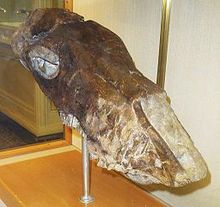Equus namadicus is a prehistoric equid, known from remains dating to the Middle and Late Pleistocene from across the Indian subcontinent, with its last dated records being approximately 29-14,000 years ago.[1] It is considered a "stenonine horse", meaning that it is probably more closely related to zebras and asses than true horses. It is relatively large in size.[2] It is very similar to the earlier Equus sivalensis, also from the Indian subcontinent, from which it only differs in size and in subtle aspects of dental anatomy,[3] and it has sometimes been suggested to be a synonym of it.[4]
| Equus namadicus Temporal range: Pleistocene
| |
|---|---|

| |
| Fossil | |
| Scientific classification | |
| Domain: | Eukaryota |
| Kingdom: | Animalia |
| Phylum: | Chordata |
| Class: | Mammalia |
| Order: | Perissodactyla |
| Family: | Equidae |
| Genus: | Equus |
| Species: | †E. namadicus
|
| Binomial name | |
| †Equus namadicus Falconer and Cautley, 1849
| |
References
edit- ^ Jukar, A. M.; Lyons, S. K.; Wagner, P. J.; Uhen, M. D. (2021-01-15). "Late Quaternary extinctions in the Indian Subcontinent". Palaeogeography, Palaeoclimatology, Palaeoecology. 562: 110137. Bibcode:2021PPP...56210137J. doi:10.1016/j.palaeo.2020.110137. ISSN 0031-0182. S2CID 228877664.
- ^ Cirilli, Omar; Machado, Helena; Arroyo-Cabrales, Joaquin; Barrón-Ortiz, Christina I.; Davis, Edward; Jass, Christopher N.; Jukar, Advait M.; Landry, Zoe; Marín-Leyva, Alejandro H.; Pandolfi, Luca; Pushkina, Diana; Rook, Lorenzo; Saarinen, Juha; Scott, Eric; Semprebon, Gina (September 2022). "Evolution of the Family Equidae, Subfamily Equinae, in North, Central and South America, Eurasia and Africa during the Plio-Pleistocene". Biology. 11 (9): 1258. doi:10.3390/biology11091258. ISSN 2079-7737. PMC 9495906. PMID 36138737.
- ^ Azzaroli, A. (1990), Lindsay, Everett H.; Fahlbusch, Volker; Mein, Pierre (eds.), "The Genus Equus in Europe", European Neogene Mammal Chronology, Boston, MA: Springer US, pp. 339–356, doi:10.1007/978-1-4899-2513-8_20, ISBN 978-1-4899-2515-2, retrieved 2022-06-28
- ^ Sun, Boyang; Liu, Wenhui; Liu, Jinyuan; Liu, Li; Jin, Changzhu (July 2021). "Equus qingyangensis in Jinyuan Cave and its palaeozoographic significance". Quaternary International. 591: 35–46. Bibcode:2021QuInt.591...35S. doi:10.1016/j.quaint.2020.10.076. S2CID 228830965.
- B.J. MacFadden, Fossil Horses, 1992
- J. Curke, A Roman Frontier Post and its People, The Fort of Newstead in the Parish of Melrose, Glasgow 1911 (appendix on animal remains [1])